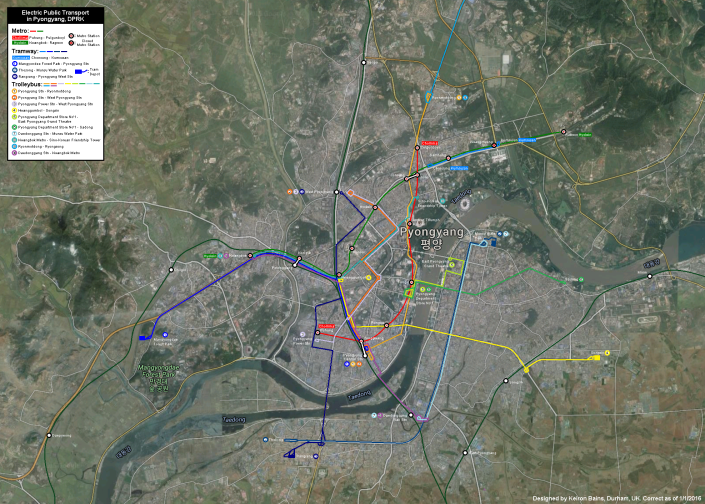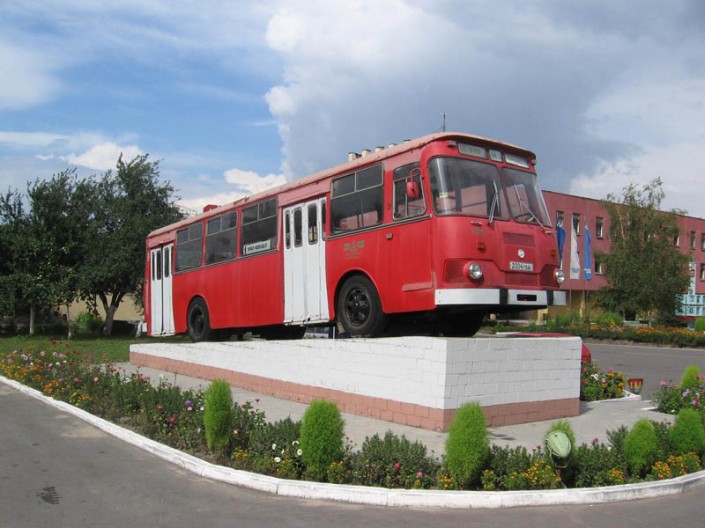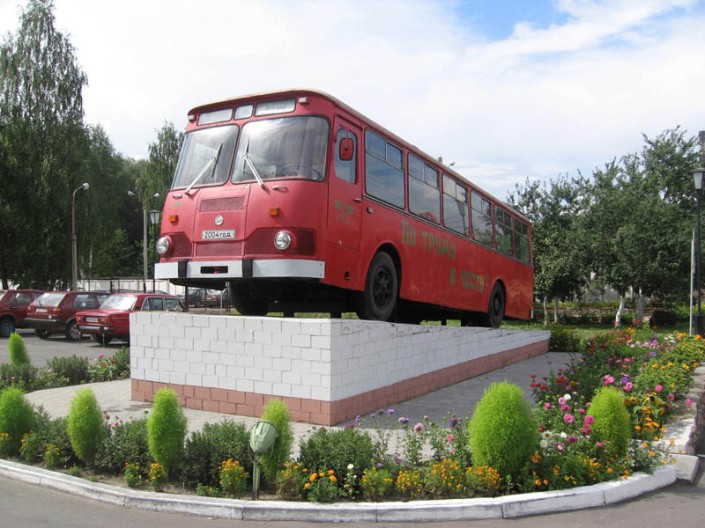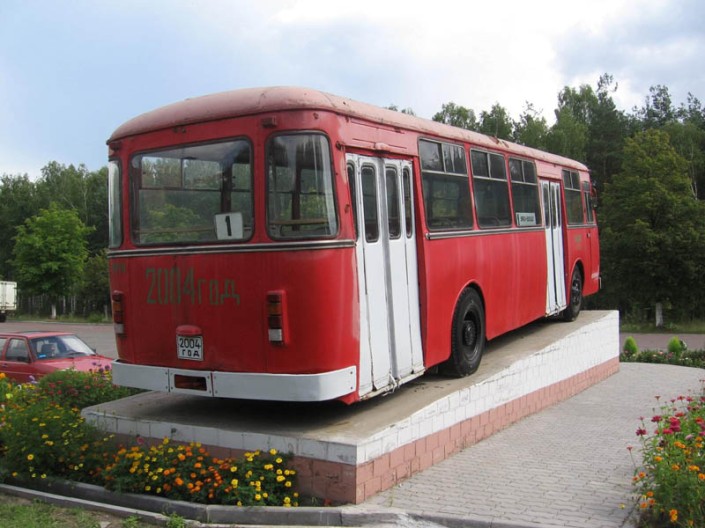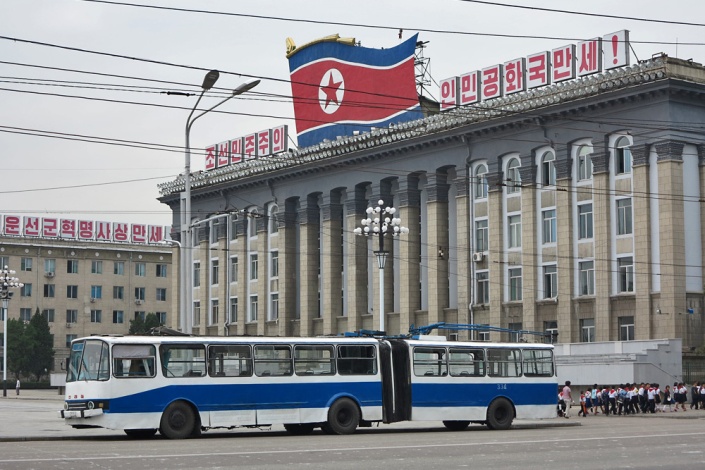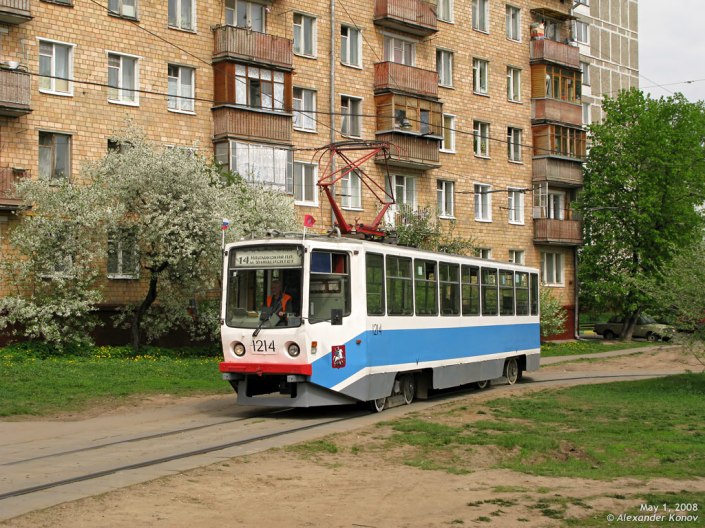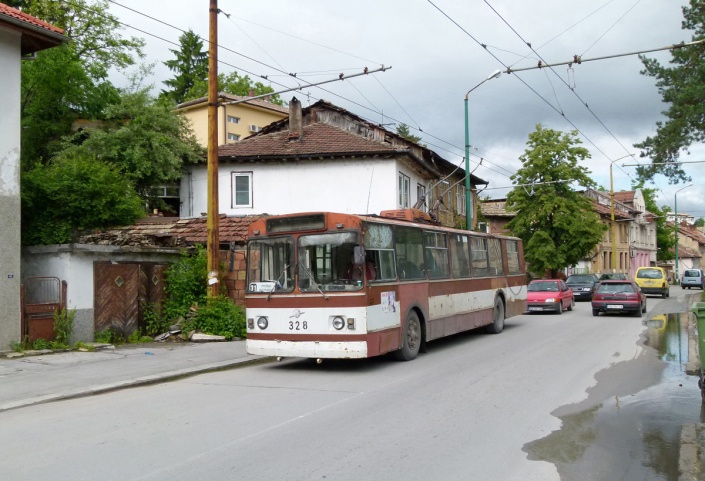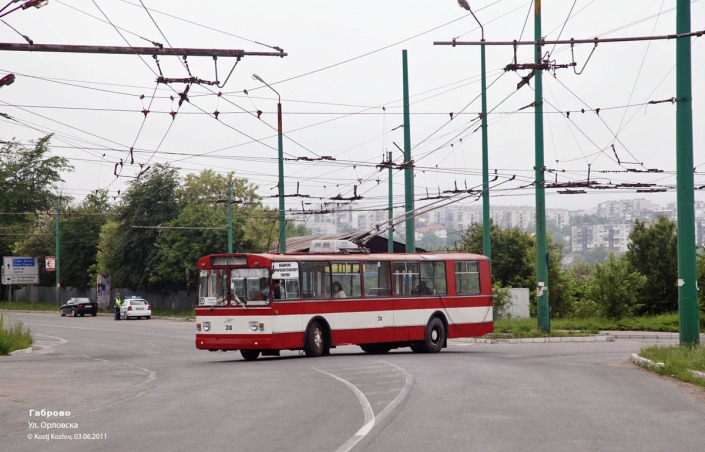Pyongyang Public Transport
I know I keep going back to Pyongyang’s public transport but it’s so interesting to see the differences between them and the rest of the world. At the start of the year I got the idea to make a map of the transport system in Pyongyang in case they ever decide to make their borders more open. With this in mind I thought I would add a blog post to describe each route in detail with the city streets being so diverse and full of monuments, museums, places of interest and propaganda.
When I initially gained the idea it was going to just include the tramways and railways (since those are pretty easy to locate) with the intention of seeing if residential growth has sprouted from them but with virtually no historic maps to look this idea was soon abandoned! The main railways were incredibly easy to locate considering the main stations are actually listed on Google maps, so those were done first in a dark green to match the main colour of the trains over there. (I have a Railway Magazine all about the North Korean railways, I will go into that another time!)
To gain an insight into the tramways in Pyongyang I looked for photos and videos online, a few photos exist on Flickr and other photo sharing websites of the trams but not as many as I would like and they were more from professional photographers wanting an insight into the crowds cramped onboard rather than an enthusiast photo of the vehicle itself. Therefore I tried on Youtube and found 2 videos that give a lengthy insight into the trams there by Daniel Möschke, a superb European transport videographer. Here are the 2 videos, 1 captured in 2014 and 1 in 2015.
By watching these I was able to notice that they operate a lot round the main railway station and where one of the depots was located which allowed me to begin tracking down where the tram lines ran too. The Mangyongdae Forest Park depot located to the West of the city is where the 2014 video starts and has some sort of museum about the tramway. I then researched about this and noticed a map of the system:
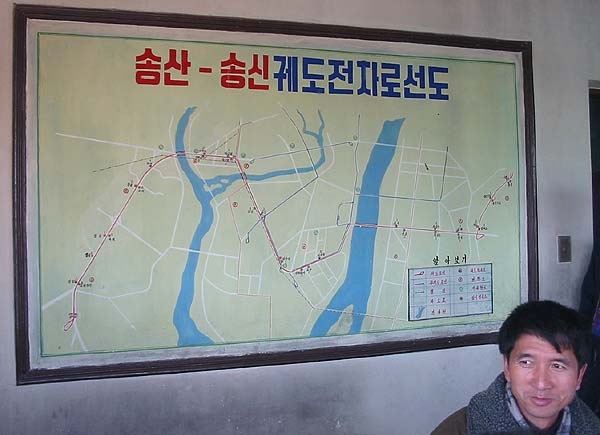
http://www.pyongyang-metro.com/metrotrams.html
What was even more useful about this map was the fact it seemed to have the individual lines listed which would make it even easier to use a transport system. I then began comparing this with Google maps and noticed something, the Eastern red part of the tramway that crosses the river Taedong seems to have disappeared. A shame to see this as I technically meant the tramway was shrinking, but on further investigation it has been noted that this part of the tram route is operated by Trolleybuses which can be backed up by Google maps with many trolleybuses seen on these roads and using the depots. Why this has been done is not clear in the slightest as the whole road has been resurfaced to remove the tram tracks.
This then sparked me to include the Trolleybus operation into the map also seeing as it also has a great presence in the city. The Trolleybus services generally were to harder to find due their being only wiring giving them away on Google Maps until I noticed the Trolleybus stations or depots scattered throughout the city. I searched online for hours about the various routes that the Trolleybuses take and what seemed interesting is that each service must have a high PVR as each route has a lot of spare vehicles in the depots. One thing that is unusual about their operation is that each route operates from one bus depot to another with presumably long layover at each end to maintain reliability. With my map being on Google maps you will be able to go the place and see what I mean.
This map is fully up to date as of the 1st January 2016, I keep in contact with many sources to see if there any changes to any of the networks, so far none have arisen! (As of 20/04/16.)
A look at…The Metrovagonmash 81-717
The Metrovagonmash 81-717/714 is a metro car designed for rapid transit systems from the Soviet Union, as well as its satellite states, in the mid-1970s. A number of Eastern European countries use modified variants of these metro cars, such as the various models used in Poland: 81-717.3, 81-714.3, 81-572, 81-573, 81-572.1, 81-573.1, 81-572.2, and 81-573.2. Most of these are visually almost identical to the 81-717 and 81-714, except for 81-572.2, which has a cabin that resembles the 81-540.2 (another Russian metro car, an improved version of the 81-717 that was first produced in 2006).
These metros are still in service in Moscow, Sofia, Warsaw, Tbilisi and Budapest. Pictured is an example operating on Line 3 in the latter city.
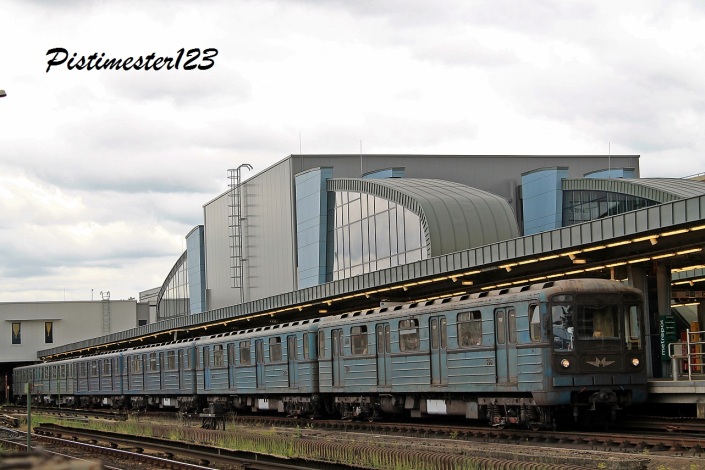
A look at…The MTV-82
The MTV-82 is a 1,524 mm (5 ft) gauge high-floor four-axle tram. It has a full metal body which is mounted on a large steel carriage with two double-axle bogies with two double doors at each end, which have pneumatic gear for opening and closing. The main brake system is also pneumatic. The MTV-82 is equipped with four 55 kW electric motors and is capable of a maximum speed of 55 km/h. The controller for the motors uses direct current, initially the MTV-82 did not have a low-voltage system, but this was added later for external braking and turn light signalisation. The vehicle has 40 seats and is able to transport nearly 120 passengers with a full load with it being 13611 mm in length, 2550 mm in width, and nearly 3000 mm in height. The overall weight without passengers is 17.5 metric tons.
Shortly after the end of World War II a strong need in new trolleybuses became apparent. This was due to a huge conversion from trams to trolley buses in many cities in the USSR. Due to this issue, the Motor and Automobile Research Institute developed a unified vehicle bodies for buses and trolleybuses, which was a copy of the ones produced by General Motors. The production of such trolleybuses started in 1946. While the plant produced only 70 complete trolleybuses, the number of produced bodies was much higher. The plant did not have a sufficient number of motor and traction parts to use these bodies for trolleybuses. These trolleybus bodies simply were stored in plant warehouses. In order to get out of this situation, Anton Ivanovich Livinenko, chief engineer of the Moscow Tram Council, suggested to use these bodies in tram production. These bodies were converted into the trams very with help from the “Transportation Overhaul Plant in Sokolniki. This re-engineering was found to be very successful. In comparison with MTB-82 Trolleybus, the capacity was increased to 120, 55 of which were seated. In early 1947 similarly with MTB-82 trolleybus, this model of tram became the MTV-82 tram.
The first prototype of the MTV-82 tramcar was built on the military Factory No. 82 (it corresponds to 82 number in the vehicle index) in 1946. Mass production started in 1947 on the Factory No. 82 and it was transferred to Rīgas Vagonbūves Rūpnīca (RVR – Latvian acronym; Рижский Вагонный Завод, РВЗ – Russian full name and acronym) in 1949. In 1961 mass production of MTV-82 in Riga ceased, it was replaced in production by its direct successor, RVZ-6 tramcar. In total, Factory No. 82 and RVR produced 453 and 1707 MTV-82s respectively. These tramcars worked until 1983 in Moscow, Kiev, Gorky, Sverdlovsk, Vladivostok and many other Soviet cities and towns. The Soviet tram drivers and repairmen found the MTV-82 very popular for its simplicity, reliability and durability. Most of MTV-82s were in operable state before scrapping, but renovation of Soviet trams was fatal for many types of “old-fashioned” Soviet tramcars.
The legendary endurance and reliability of MTV-82 trams makes them ideal for use in non-revenue service. After being retired or removed from passenger service, many MTV-82 trams were converted into service trams. They could be used for towing other trams, as hoppers, freight trams, etc. In the cities of Odessa, and Zaparozh’je a couple of MTV-82 trams were rebuilt into unique double ended (2 cab) version. In Odessa, such 2-cab trams were in use on the picturesque single track route #19. In Zaparozh’e they were used on route #5.
Three MTV-82s survive. Moscow (pictured) and Ekaterinburg have two operable MTV-82 in their tramway systems. Nizhny Novgorod tram & trolley museum has a third operable MTV-82 in its tramcar collection. These MTV-82s do not serve as usual tramcars, but can be hired for city excursions (but this is quite a long, formal and bureaucratic procedure in today’s Russia). with guests from Estonia and United States hired Nizhny Novgorod Museum MTV-82 for their meeting in 2004.
Odessa Transport Authority found unique solutions to existing MTV tramcars in their possession. One of them is car #914, which was converted into an open “retro-style” excursion tram. Its design was modified to commemorate Pullmans of the early 20th century, along with historical dark-red livery. Car #914 can be seen running both along the “excursion routes” and Route 5, the most picturesque tram route in Odessa.
This is car 1278 with GUP Mosgortrans, the public operator that has an incredible heritage fleet and keep them in remarkable condition. Shame they only go out once a year….. One thing I must say about the Soviets, they can build some beautiful vehicles….just look at it!
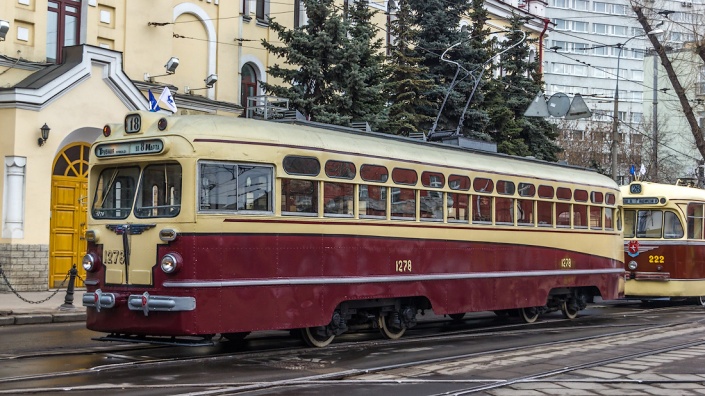
Another quick look at: Pyongyang, North Korea
Pyongyang, Democratic Republic of North Korea. One of the most secretive countries in the world, but home to an interesting public transportation system; most of it based off the now defunct communist giant of the USSR. They operate a small trolleybus system, as well as a small amount of motorbus services, a tram system and a Metro system. A collection of their locally manufactured (and rebuilt) Chollima Trolleybuses are sat spare at the depot. Some vehicles are rebuilt Western communist-built vehicles, such as the one on the left, a Hungarian built Ikarus 255.74 motorbus now used as a Trolleybus tower vehicle for repairs. Another popular choice is the Czechoslovakian built Karosa B732 but none are pictured here.
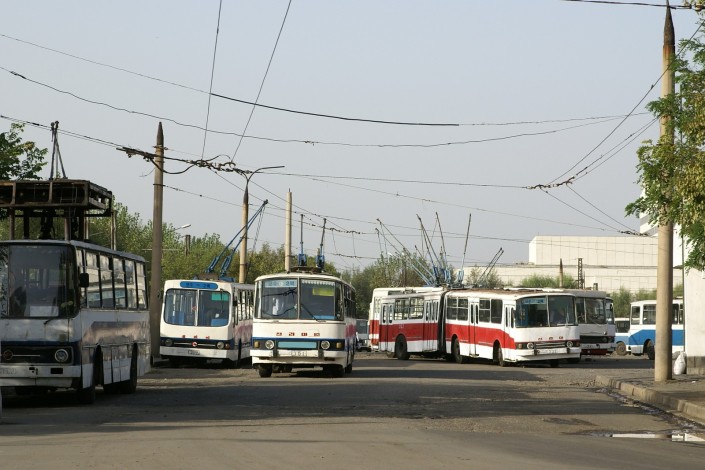
Buses from around the World – Part 5
“Isolated, polluted and – above all – cold, it is a city built on misery and blood.”
Welcome to the “edge of the world”; the city of Норильск “Norilsk” is located above the Arctic Circle between the Taymyr Peninsula and the Yenisei River in Krasnoyarsk Krai in the depths of Northern Siberia in Russia. Norilsk closed in November 2001 to all non-Russian citizens except those of Belaruisan background, the population of the city in 2015 approximately 176,251. Норильск was founded at the end of the 1920’s with the area growing into a small village in about 1935 when the mining-metallurgic complex and the Norillag system of GULAG labour camps opened. It became an urban-type settlement in 1939 and gained town status as late as 1953. Over the 20 years from 1935 over 500,000 slaves from GULAG’s took part in the cities construction and due to the harsh climate many of these lost their lives.
Норильск is located 250 miles north of the Arctic Circle so has an incredibly harsh subarctic climate and is covered with snow for about 250-270 days each year with about 110-130 days of those being heavy snow-storms. During the depths of winter the temperatures regularly plummet to -40’C and the city has complete darkness for over 2 months whereas during the summer period has 2 months of constant daytime with temperatures exceeding 20’C at times. The Норильск citizens suffer ‘the polar night syndrome’, resulting in anxiety, nervousness, drowsiness or insomnia, depending of the seasons, whiles the psychological discomfort and poor emotional stimuli also generate many cases of depression. Throughout the entire year the average temperature is -10’C. Due to its geographical location and heavy industrialisation most of Норильск is in naturally treeless tundra and very few foliage and trees exist in the city. In the winter, children are allowed for a walk outside only under certain conditions. Sometimes children have to spend several months indoors so most of the city is indoors. Such as sports facilities and shopping centres and social gatherings in apartments. Children are often forced to spend several months indoors so the city has large buildings where they can enjoy outdoor activities like cycling and running, even during the winter.
Норильск is one of the most polluted cities in the world due its huge deposits of nickel, copper, cobalt, platinum, palladium and coal therefore the city is full of mining and metallurgical complexes. The largest of these factories is a smelting plant for Nickel which regularly produces thick smog and acid rain across the city, the plant contributes to 1% of the worlds sulphur dioxide emissions. 4,000,000 tons of cadmium, copper, lead, nickel, arsenic, selenium and zinc are released into the air every year. As well as this, nearly 2,000,000 tons of carbon pollutants are released into the atmosphere each year, this is almost 6 times the amount of the 333,000 tons let into the atmosphere from Cherepovets, Russia’s second polluted city. With heavy metal pollution being so severe, it has now become economically viable to mine surface soil due to it containing such high concentrations of platinum and palladium. The citizens working in these facilities are incredibly tough with high risks involved in the mining and metallurgy industry. The shift pattern in such industries follows a pattern of 3 straight working days with 1 day off. The compensation for the risks is represented by long duration of official holidays with 90 days a year and a retirement age of 45.
Due to the high industry, the life expectancy is 10 years less than in other regions of Russia; the risk of cancer is two time higher and respiratory diseases are widespread. Studies show that the air quality is responsible for 37 per cent of deaths of child deaths and 21.6 per cent of adult deaths. The polar days and nights cycle also has a strong influence on the human body, which struggles to adapt to such extreme conditions. The darkness causes a reduction in the release of the hormone melatonin, which regulates many functions of the body which leads to sleep and nervous system problems, constant fatigue, psychological discomfort and depression. A lack of melatonin also aids premature aging of the body and promotes the development of cancer.
With the area being so inhospitable, it is literally cut-off from the rest of the world, the city only has one railway (one of the northernmost railway in the world) which operates freight-only services from the city to Port Dudinka where they are then transported by boat on the Arctic Ocean on the Yenisei River. To assist the cargo ships traveling through the thick ice, 23 nuclear-powered ice-breakers ships; each the size of a cruise-liner; operates around the harbour and the surrounding area. The city does have a road network and the usual straight and wide streets of a USSR settlement but has no connection to the national road network. You can only arrive at the city by air transport at either Norilsk Alykel Airport or Norilsk Valek Airfield.
The city is also home to a number of cultural highlights in its relatively short history, these including a history museum, art gallery, a Drama Theatre, a zoo, a cultural enter, a sports and entertainment complex and arena. There are also many monuments and historical buildings, these including the Lenin Monument of Norilsk, the Nurd Kamal, the world’s most northernmost mosque and the Monument to the city builders.
As you can imagine in such an extreme place, an incredibly important transport system needs to connect the people of Norilsk for work, shopping and the entertainment facilities. Norilsk has various taxi operators covering the city but a large scale publically-owned motorbus operator exist in Norilsk called МУП “Норильский производственное объединение пассажирского транспорта” or “НПОПАТ” for short. (MUP “Norilsk industrial association of passenger vehicles” or “NPOPAT” for short).
From the start of the city, Norilsk operated their own bus services from the copper plant (with depot on site) to the city to get the citizens to work, but as the city grew the services were often overcrowded. Therefore in 1953 a new transport decree from the USSR Council of Ministers on 17 May 1954 to create defined by separation from the TSATK independent passenger motor transportation office Krayavtoshosdora. On the 14th of July 1954, the decree was issued by the Norilsk passenger road transport office and thus began the duties of chief Norilsk Patka Safrontsom Joseph Feofanovich, the head of “НПОПАТ”.
In 2013, МУП “НПОПАТ” the volume of traffic on the city’s municipal transport amounted to 20 million passengers across 18 city routes, as well as 55 contracts, performed by order Zlatoust Branch offices of JSC “MMC” Norilsk Nickel and other organisations. МУП “НПОПАТ” have a fleet size of 264 motorbuses across 3 depots, one in Norilsk, one in nearby Talnakh and one in Kayerkan.
Due to the extreme conditions safety is paramount, so the МУП “НПОПАТ” have a satellite navigation system to track vehicles to maintain regularity on their bus routes for further efficiency. Also, with many of the factories operating 24 hours МУП “НПОПАТ” also operate around the clock 24/7. However the most impressive feature of the company is the operation of services during harsh wintry snowstorms. With it being so unsafe to be outside during these conditions but citizens needing to work and get around the city, МУП “НПОПАТ” operate 40 buses in one convoy 3 times a day which operate from the city to take workers to the factories to ensure maximum safety in case of a vehicle breakdown then passengers can easily be evacuated onto another vehicle to deter standing outside for long periods of time during these harsh conditions.
The Norilsk depot operates:
– 68 МАЗ-103.075
– 24 МАЗ-103.476
– 13 ПАЗ-32054-67 (3205*M)
– 12 МАЗ-206.086
– 10 МАЗ-206.085
– 9 ПАЗ-320401-01 (32041A)
– 1 ЛиАЗ-5293.00
– 1 МАЗ-103.С70
– 1 МАЗ-152.060
The Talnakh depot operates:
– 43 МАЗ-103.075
– 17 МАЗ-103.476
– 3 ПАЗ-32054-67 (3205*M)
– 8 МАЗ-103.486
– 5 МАЗ-206.085
– 1 ПАЗ-320401-01 (32041A)
– 1 МАЗ-206.086
– 1 ЛиАЗ-5293.00
The Kayerkan depot operates:
– 49 МАЗ-103.075
– 9 МАЗ-103.476
– 7 МАЗ-103.486
– 5 ПАЗ-32054-67 (3205*M)
– 1 МАЗ-103.070
* Correct as of 19/03/2016 *
Норильск
Bus Route maps:
1A – http://npopat.com/images/Shem/1%D0%90-%D0%94%D1%83%D0%B1%D0%BB%D1%8C%D0%93%D0%B8%D1%81-%D0%9D%D0%BE%D1%80%D0%B8%D0%BB%D1%8C%D1%81%D0%BA.jpg
1B – http://npopat.com/images/Shem/1%D0%91-%D0%94%D1%83%D0%B1%D0%BB%D1%8C%D0%93%D0%B8%D1%81-%D0%9D%D0%BE%D1%80%D0%B8%D0%BB%D1%8C%D1%81%D0%BA.jpg
2 – http://npopat.com/images/Shem/2-%D0%94%D1%83%D0%B1%D0%BB%D1%8C%D0%93%D0%B8%D1%81-%D0%9D%D0%BE%D1%80%D0%B8%D0%BB%D1%8C%D1%81%D0%BA.jpg
4 – http://npopat.com/images/Shem/4-%D0%94%D1%83%D0%B1%D0%BB%D1%8C%D0%93%D0%B8%D1%81-%D0%9D%D0%BE%D1%80%D0%B8%D0%BB%D1%8C%D1%81%D0%BA.jpg
5A – http://npopat.com/images/Shem/5%D0%90-%D0%94%D1%83%D0%B1%D0%BB%D1%8C%D0%93%D0%B8%D1%81-%D0%9D%D0%BE%D1%80%D0%B8%D0%BB%D1%8C%D1%81%D0%BA.jpg
5B – http://npopat.com/images/Shem/5%D0%91-%D0%94%D1%83%D0%B1%D0%BB%D1%8C%D0%93%D0%B8%D1%81-%D0%9D%D0%BE%D1%80%D0%B8%D0%BB%D1%8C%D1%81%D0%BA.jpg
6 – http://npopat.com/images/Shem/6-%D0%94%D1%83%D0%B1%D0%BB%D1%8C%D0%93%D0%B8%D1%81-%D0%9D%D0%BE%D1%80%D0%B8%D0%BB%D1%8C%D1%81%D0%BA.jpg
11 – http://npopat.com/images/Shem/11-%D0%94%D1%83%D0%B1%D0%BB%D1%8C%D0%93%D0%B8%D1%81-%D0%9D%D0%BE%D1%80%D0%B8%D0%BB%D1%8C%D1%81%D0%BA.jpg
11y – http://npopat.com/images/Shem/11%D0%A3-%D0%94%D1%83%D0%B1%D0%BB%D1%8C%D0%93%D0%B8%D1%81-%D0%9D%D0%BE%D1%80%D0%B8%D0%BB%D1%8C%D1%81%D0%BA.jpg
12 – http://npopat.com/images/Shem/12-%D0%94%D1%83%D0%B1%D0%BB%D1%8C%D0%93%D0%B8%D1%81-%D0%9D%D0%BE%D1%80%D0%B8%D0%BB%D1%8C%D1%81%D0%BA.jpg
14A – http://npopat.com/images/Shem/14%D0%90-%D0%94%D1%83%D0%B1%D0%BB%D1%8C%D0%93%D0%B8%D1%81-%D0%9D%D0%BE%D1%80%D0%B8%D0%BB%D1%8C%D1%81%D0%BA.jpg
14B – http://npopat.com/images/Shem/14%D0%91-%D0%94%D1%83%D0%B1%D0%BB%D1%8C%D0%93%D0%B8%D1%81-%D0%9D%D0%BE%D1%80%D0%B8%D0%BB%D1%8C%D1%81%D0%BA.jpg
15 – http://npopat.com/images/Shem/15-%D0%94%D1%83%D0%B1%D0%BB%D1%8C%D0%93%D0%B8%D1%81-%D0%9D%D0%BE%D1%80%D0%B8%D0%BB%D1%8C%D1%81%D0%BA.jpg
16A – http://npopat.com/images/Shem/16%D0%90-%D0%94%D1%83%D0%B1%D0%BB%D1%8C%D0%93%D0%B8%D1%81-%D0%9D%D0%BE%D1%80%D0%B8%D0%BB%D1%8C%D1%81%D0%BA.jpg
16B – http://npopat.com/images/Shem/16%D0%91-%D0%94%D1%83%D0%B1%D0%BB%D1%8C%D0%93%D0%B8%D1%81-%D0%9D%D0%BE%D1%80%D0%B8%D0%BB%D1%8C%D1%81%D0%BA.jpg
17 – http://npopat.com/images/Shem/17-%D0%94%D1%83%D0%B1%D0%BB%D1%8C%D0%93%D0%B8%D1%81-%D0%9D%D0%BE%D1%80%D0%B8%D0%BB%D1%8C%D1%81%D0%BA.jpg
40 – http://npopat.com/images/Shem/40-%D0%94%D1%83%D0%B1%D0%BB%D1%8C%D0%93%D0%B8%D1%81-%D0%9D%D0%BE%D1%80%D0%B8%D0%BB%D1%8C%D1%81%D0%BA.jpg
41 – http://npopat.com/images/Shem/41-%D0%94%D1%83%D0%B1%D0%BB%D1%8C%D0%93%D0%B8%D1%81-%D0%9D%D0%BE%D1%80%D0%B8%D0%BB%D1%8C%D1%81%D0%BA.jpg
Норильск
Bus Timetables
1A/1B – https://translate.googleusercontent.com/translate_c?act=url&depth=1&hl=en&ie=UTF8&prev=_t&rurl=translate.google.com&sl=auto&tl=en&u=http://npopat.com/index.php/marshruty-i-raspisaniya/raspisaniya/item/download/18_92eba5647701df4d57b44d1ecbf976d4%3Fswitch_to_desktop_ui%3D1&usg=ALkJrhhRg5-Nbxa-fSKpwZ54TC3Vu5eh7A
2 – https://translate.googleusercontent.com/translate_c?act=url&depth=1&hl=en&ie=UTF8&prev=_t&rurl=translate.google.com&sl=auto&tl=en&u=http://npopat.com/index.php/marshruty-i-raspisaniya/raspisaniya/item/download/19_42c5d1fb2c921395d4f2baa121f444b5%3Fswitch_to_desktop_ui%3D1&usg=ALkJrhjM6_i_WWu-MS6q0Kng7gtmMNQTzQ
4 – https://translate.googleusercontent.com/translate_c?act=url&depth=1&hl=en&ie=UTF8&prev=_t&rurl=translate.google.com&sl=auto&tl=en&u=http://npopat.com/index.php/marshruty-i-raspisaniya/raspisaniya/item/download/20_3c5e01da85374e79453a181f4a6b91b6%3Fswitch_to_desktop_ui%3D1&usg=ALkJrhg9hy3GUHzoJvENnd2KciRV_D0DNg
5A/5B – https://translate.googleusercontent.com/translate_c?act=url&depth=1&hl=en&ie=UTF8&prev=_t&rurl=translate.google.com&sl=auto&tl=en&u=http://npopat.com/index.php/marshruty-i-raspisaniya/raspisaniya/item/download/21_bf49cede9d4257f9ae28505db0fcda86%3Fswitch_to_desktop_ui%3D1&usg=ALkJrhgKqflnF-cVm4aKJ80ZPC6Vi6lFZQ
6 – https://translate.googleusercontent.com/translate_c?act=url&depth=1&hl=en&ie=UTF8&prev=_t&rurl=translate.google.com&sl=auto&tl=en&u=http://npopat.com/index.php/marshruty-i-raspisaniya/raspisaniya/item/download/22_971e027f96c838425dd5b822dcaddfac%3Fswitch_to_desktop_ui%3D1&usg=ALkJrhg5fqsR5ZWFuGU9iwr6GPnOF2GaWg
11 – https://translate.googleusercontent.com/translate_c?act=url&depth=1&hl=en&ie=UTF8&prev=_t&rurl=translate.google.com&sl=auto&tl=en&u=http://npopat.com/index.php/marshruty-i-raspisaniya/raspisaniya/item/download/23_a20c0039e72b985efb21aafe3dc9c9b4%3Fswitch_to_desktop_ui%3D1&usg=ALkJrhhonUXcrT3xex1jUQPPEvuBRpYfkA
12 – https://translate.googleusercontent.com/translate_c?act=url&depth=1&hl=en&ie=UTF8&prev=_t&rurl=translate.google.com&sl=auto&tl=en&u=http://npopat.com/index.php/marshruty-i-raspisaniya/raspisaniya/item/download/24_9732d7ee9061293092f1eada7c8510d0%3Fswitch_to_desktop_ui%3D1&usg=ALkJrhgdWGNOPELQwNtGiDodOXy7H82Khg
14 – https://translate.googleusercontent.com/translate_c?act=url&depth=1&hl=en&ie=UTF8&prev=_t&rurl=translate.google.com&sl=auto&tl=en&u=http://npopat.com/index.php/marshruty-i-raspisaniya/raspisaniya/item/download/25_8eab880749c8a037a41e1bb179958099%3Fswitch_to_desktop_ui%3D1&usg=ALkJrhi9U4QQuTIcFhdTeEjVF9js1ex9xA
15 – https://translate.googleusercontent.com/translate_c?act=url&depth=1&hl=en&ie=UTF8&prev=_t&rurl=translate.google.com&sl=auto&tl=en&u=http://npopat.com/index.php/marshruty-i-raspisaniya/raspisaniya/item/download/26_889153698d2eb86608596eb07118fc55%3Fswitch_to_desktop_ui%3D1&usg=ALkJrhjW_5X03ytMkkwaIB_FhGoIAUpcTQ
16A/16B – https://translate.googleusercontent.com/translate_c?act=url&depth=1&hl=en&ie=UTF8&prev=_t&rurl=translate.google.com&sl=auto&tl=en&u=http://npopat.com/index.php/marshruty-i-raspisaniya/raspisaniya/item/download/27_a6556c1491b90f158b010c06ec682115%3Fswitch_to_desktop_ui%3D1&usg=ALkJrhiBoA8w8snRjNHot6B8j5Zqj3Vzyw
17 – https://translate.googleusercontent.com/translate_c?act=url&depth=1&hl=en&ie=UTF8&prev=_t&rurl=translate.google.com&sl=auto&tl=en&u=http://npopat.com/index.php/marshruty-i-raspisaniya/raspisaniya/item/download/28_ee35bde7398e9fb9cb629042d1c2748f%3Fswitch_to_desktop_ui%3D1&usg=ALkJrhgRfuht0pdsRSZfL0p0_Lb7wBlbjw
22 – https://translate.googleusercontent.com/translate_c?act=url&depth=1&hl=en&ie=UTF8&prev=_t&rurl=translate.google.com&sl=auto&tl=en&u=http://npopat.com/index.php/marshruty-i-raspisaniya/raspisaniya/item/download/29_6e0a8aa3a339d6ab85afe75b0ad8accb%3Fswitch_to_desktop_ui%3D1&usg=ALkJrhhpQPJuAnTWzB41-0TAl9RuVRkV5AOGQ
24 – https://translate.googleusercontent.com/translate_c?act=url&depth=1&hl=en&ie=UTF8&prev=_t&rurl=translate.google.com&sl=auto&tl=en&u=http://npopat.com/index.php/marshruty-i-raspisaniya/raspisaniya/item/download/31_7153e471b1e65a30f9c45baefc90ff34%3Fswitch_to_desktop_ui%3D1&usg=ALkJrhjn2677l_PDdWrI2g8foC5vMtv6Iw
31 – https://translate.google.com/translate_c?act=url&depth=1&hl=en&ie=UTF8&langpair=en|en&prev=_t&rurl=translate.google.com&u=http://npopat.com/index.php/marshruty-i-raspisaniya/raspisaniya/item/download/32_a37aaf377cfca5ca8abef0f455f6e3ec%3Fswitch_to_desktop_ui%3D1&usg=ALkJrhhWmuM4UbDowSSVrbP3wijsjZbXHw
33 – https://translate.googleusercontent.com/translate_c?act=url&depth=1&hl=en&ie=UTF8&prev=_t&rurl=translate.google.com&sl=auto&tl=en&u=http://npopat.com/index.php/marshruty-i-raspisaniya/raspisaniya/item/download/33_998a0a63d4ed237489a51851ecb80cb9%3Fswitch_to_desktop_ui%3D1&usg=ALkJrhhnRT3gblJe7heCuRCPH1j4E06nzA
40 – https://translate.googleusercontent.com/translate_c?act=url&depth=1&hl=en&ie=UTF8&prev=_t&rurl=translate.google.com&sl=auto&tl=en&u=http://npopat.com/index.php/marshruty-i-raspisaniya/raspisaniya/item/download/34_eea6bff4738711e773e0314fef2656d9%3Fswitch_to_desktop_ui%3D1&usg=ALkJrhjCuMSPcjjHWMqvm-R0Wl_J5lBpWg=
41 – https://translate.googleusercontent.com/translate_c?act=url&depth=1&hl=en&ie=UTF8&prev=_t&rurl=translate.google.com&sl=auto&tl=en&u=http://npopat.com/index.php/marshruty-i-raspisaniya/raspisaniya/item/download/35_c2a12e865cf363195d8b2dd74cbc2244%3Fswitch_to_desktop_ui%3D1&usg=ALkJrhgXSBaZ_ONla7bD6mci9rzQqt5fUQ
The МАЗ-103 (MAZ-103) is a Belarusian built vehicle dating from 1996 built in Minsk, Belarus as the Минским автомобильным заводом (Minsk Automobile Plant).
In 1992, МАЗ signed a license agreement with the German manufacturer Neoplan to reproduce under contract the Neoplan N4016 model in Eastern Europe. This came in the form of the МАЗ-101 but its low price and reliability in operation on the poor quality roads of poor quality made it uncompetitive in the Commonwealth of Independent States “CIS” market. As a result, only five licensed buses were built in a “pure form”. At the plant, it was decided to introduce more Eastern components, at the same time adapting the design to the local conditions. Following these changes the new vehicle was named the МАЗ-103; the power was now acting on the rear axle instead of the portal axle like on the МАЗ-101. This led to the stairs at the back doors with the middle and front having a low floor. This made a positive impact on price, reliability and maintainability of the vehicle.
The Russian assembly of МАЗ-103 buses was carried out in Nizhny Novgorod at the facilities of the company “Samotlor-NN”. These buses have a different front mask with round headlights smaller. Since 2008, it produced restyled version of the bus with a more modern design, exterior and interior.
The example in the photo is a МАЗ-103.075 which comes along with various modifications compared to the standard version to enable reliable operation in extreme temperatures. It seats 29 passengers with a total capacity of 100 passengers. It’s powered by a 231hp Euro 3 Diesel Deutz BF6M1013EC engine coupled with a 3 speed Voith DIWA D851.3E automatic gearbox. They also use special additives in their diesel fuel to stop it solidifying into a partially crystalline state where it can thicken the oil and clog fuel filters and injectors in engines, which of course would fill up in the fuel line until the engine was starved of diesel and would cut out. Not something you need at -40’C in a heavy snowstorm! Therefore all of the МУП “НПОПАТ” vehicles use Artic Diesel Fuel which has a density of 830 kg/m³, a flash point of 35’C, a maximum pour point of 35’C, a minimum pour point of -50’C and a viscosity of 1.4-4.0 mm²/s.
The Cold Filter Plugging Point (CFPP) is based on a standardised test that indicates the rate at which diesel fuel will flow through a standardised filtration device in a specified length of time when cooled under certain conditions. Similarly the “Low Temperature Flow Test” indicates the winter performance of diesel with improver additives. Note that both the CFPP and LTFT temperature is some degrees above the Pour Point temperature at which diesel fuel loses its fluid character and that pumps would stop operating.
As well as these features, the МАЗ-103.075 has technology fitted to the engine to enable running in cold weather conditions, one of these being a spill return system. Once the vehicle is started, usually at temperatures below the CFPP any excess fuel from the injector pump and injectors is returned back into the fuel tank. So once the engine has begun warming up the returning fuel increases the temperature of the fuel already in the fuel tank preventing gelling. As well as this low-output electric heaters are found in the fuel tanks and around fuel lines which extend the fluid characteristics of diesel fuel. As well as this they all have a higher window line and no opening windows or vents for passengers to discourage draughts inside the vehicle.
Featured this time around is МУП “НПОПАТ” Норильск based МАЗ-103.075 No. 638 АН 638 24 built in 2004. It’s wearing the standard livery of all-over yellow livery (designed to stand out in the regular whiteouts). As per most Russian operators, the driver is only responsible for the driving of the vehicle leaving the conductor to take charge of fares leaving the driver in the whole front of the bus. It is seen operating a 5A service towards ОВЦ – ул. Комсомольская (Regional Exbn – Komsomolskaya Street) on Заводская улица (Zavodskaya Ulitsa) on Sunday the 16th of March 2014. This shot gives a clear view of the environment in Norilsk, with it being March the winter is beginning to end with the average temperatures up to -22 (WOW). Note the amount of drift snow up on the building on the right also!
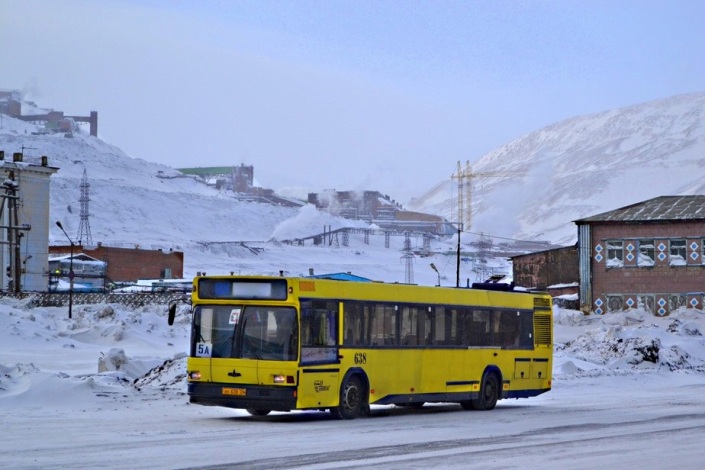
Photo by Aztec from http://fotobus.msk.ru/photo/1085766/
http://fotobus.msk.ru/list.php?grid=112
https://en.wikipedia.org/wiki/Norilsk
http://www.nornik.ru/en/main
http://www.dailymail.co.uk/travel/travel_news/article-3416963/Think-s-cold-Spare-thought-residents-Norilsk-northernmost-city-world-endure-temperatures-55-C-two-months-24-7-darkness-year.html
http://www.nbcnews.com/news/photo/what-real-russian-winter-looks-n21
http://proof.nationalgeographic.com/2014/01/06/russians-adapt-to-a-freezing-dark-and-polluted-place/251
Bus Monuments!
The Russians are incredibly proud of their Soviet creations such as aircraft and military; many of which still survive today. However, something that is not seen in Britain are actual monuments of old Soviet USSR built vehicles, such as aircraft, trucks and tanks. However another popular focus for monuments are Communist built motorbuses, this particular example being a LiAZ 677m – one of the most iconic buses built-in Russia with 194,183 buses built from the Ликинский автобусный завод (ЛиАЗ) Likinskiy Avtobusnyi Zavod (Likino Bus Plant) over the 29 years from 1967. Therefore in recent years, a large amount of these are dissapearing from the streets so many are purchasing them and displaying them on beautifully created monuments reminding people of the machines from the past that served the USSR so well.
In 2004, the Bus fleet Number 5 Svetlogorsk depot were scrapping the last ten buses LiAZ-677, one of these were saved and mounted on a pedestal in front of the bus depot which is pictured. At the opening of the monument the honored guests consisted of the city administration General Director of “Gomeloblavtotrans” and a representative of Likino Bus Plant (Likino-Dulevo). They also had a photographic oppurtunity with the last driver of the bus, Andrew Samsonovich Skid (Андрей Самсонович Полозок) who is now retired.
This monument is found in the city of Светлогорск (Svetlogorsk) in Belarus and taken by Paul Beresnev (Павел Береснев).
A quick look at: Pyongyang, North Korea
Pyongyang, Democratic Republic of North Korea. One of the most secretive countries in the world, but home to an interesting public transportation system; most of it based off the now defunct communist giant of the USSR. They operate a small trolleybus system, as well as a small amount of motorbus services, a tram system and a Metro system. One of the locally manufactured Chollima 862’s; No’ 334; lays over in front of the main government building at Kim Il Sung square; of course showing off the countries pride of it’s leader (not visible in the photograph but leader Kim Jong Un adorns the centre of the building).
Random Photograph from Europe No’ 4
ГУП Мосгортранс (GUP Mosgortrans) УКВЗ 71-608КМ No.1214 is seen working a 14 Line in Cheremushki terminus station, Moscow in front of some rather typical USSR apartments. It is decorated with Russian flags as it was the May Day bank holiday when photographed in 2008. This class are very close to withdrawel due to new units being delivered. One thing that is unusual is that Moscow predominantly use single tram cars unlike other European cities where articulated tramcars are the norm. This particular unit is a УКВЗ 71-608КМ with 2 Динамо ДК-259Е 68HP motors built in 1995 and are the oldest type on the network.
Buses from around the World – Part 4
We have been looking at larger operators for the past 3, now for the 4th one we will have a look at a much smaller operator in the east end of Europe. Gabrovo is a city situated at the northern foot of the Stara Planina mountains range, near the Shipka pass, in the valley of the Yantra River in Bulgaria. Gabrovo is also known as the longest city in the country, stretching over 25 km along the Yantra, yet reaching only 1 km in width at places. It is known as an international capital of humor and satire, as well as noted for its Bulgarian National Revival architecture.
Общински Пътнически Транспорт ЕООД Габрово (Municipal Passenger Transport Ltd Gabrovo) or ОПТ are a public-owned transport operator based in Gabrovo, Bulgaria. They employ 208 staff and have 13 trolleybuses and 64 motorbuses to operate 22 bus lines and 4 majorly peak-time trolleybus routes. They also have a custom built depot facility which is well equipped and allows for heavy maintenance of their service fleet. They also have their own bus station in the city centre which has waiting rooms, toilets and also houses their offices. The bus station itself is served by 26 city, 14 long-distance and inter-city bus lines but other motorbus lines dont serve it directly and no trolleybus services can either (due to lack of infrastructure!).
At the moment the fairly new Transport Market initiative occupies:-
– 97% of public transport in the inner city area which includes the routes of the movement of buses and trolleys, timetables, stops which is approved by the Municipal Council of Gabrovo
– 94% of the long-distance transport connecting Gabrovo with nearby villages within the municipality of Gabrovo.
Due to it’s lack of to its competition from other operators, the company transports more inter-transport schemes, as well as random services (free routes chosen by the customer such as pleasure trips in the country) and specialised services (contracts with customers – businesses, organizations). OPT Gabrovo is a major company in the municipality of Gabrovo, their services meet the needs of the customer, including preferential trips – free for passengers, such as war veterans and war invalids. Therefore it can be said that the trading partner of the company is public. At present the company is a single member limited liability company with 100% municipal property.
ОПТ Габрово is a new venture formed in 1997 where the Ministry of Transport in ‘Sofia’ transfered ownership of transport companies to transport passengers within the city of Gabrovo, (essentially publically operated). This was decided at a meeting held with the municipal and state in Gabrovo City Council which led to a municipal company for passenger transport. Company “Municipal Passenger Transport” Gabrovo was formed by Decision № 861 from 25.06.1997, by merging “Gabrovo cars” Ltd., Gabrovo, “Trolley Transport” Gabrovo and “complex charges “Ltd., Gabrovo which were the previosu private operators of transport. Since 1987 the city has a small trolleybus system (about 24.7km) which the is the topic of this photograph. 32 vehicles were purchased when the system opened; all to the ЗиУ (ZIU) design.
Currently ОПТ Габрово operate Trolleybus routes 31, 32, 33, 34; most of which operate Monday to Friday usually till about 20:00.
Line 31 is operated with diesel buses on weekends, however, the 32, 33 and 34 are not operated on weekends at all. The Route 33 is the main trolleybus service operating every 20 minutes. This operates from the north-west estate of Русевци (Rusevtsi) to the south-east estate of Шиваров мост (Shivarov Most). The 31 then extends beyond Шиваров мост (Shivarov Most) and terminates at the Резбонарезни инструменти Габрово ЕООД (Threading tools Gabrovo Ltd) factory who design, develop and produce threading, boring and gear cuttong tools which also operares every 20 minutes giving a service every 10 minutes between Русевци (Rusevtsi) and Шиваров мост (Shivarov Most). During peak times all 31/33 trolleybuses operate the full length to Резбонарезни инструменти Габрово ЕООД (Threading tools Gabrovo Ltd) eveyr 10 minutes with no short turn service 33. The 31 is the only regular trolleybus service to the large residential neighborhood of Бичкиня (Bichkinya) in the south of the city, but due to the information above runs Monday to Friday only leaving shoppers and general passengers to use the services 1 and 14 which are operated by diesel buses. This area remains without trolleybus service during midday on weekdays, and on weekends, with diesel buses providing service instead.
The 34 also serves Резбонарезни инструменти Габрово ЕООД (Threading tools Gabrovo Ltd) but operates only hourly and this heads towards Техномат (Tehnomat), an industrial estate to the north of the city passing through the city centre. A route map of all trolleybus lines can be found here: (http://ymtram.mashke.org/bulgaria/gabrovo/maps/gabrovo_map_2013.png) as well as timetable information of all trolleybus services: (http://ymtram.mashke.org/bulgaria/gabrovo/gabrovo_timetable_2014.pdf).
The original terminus of the 32 and the now withdrawn 30 was right in the heart of the city centre along Улица Генерал Николов (Ulitsa General Nikolov) to Pекорд (Record), a small housing estate but this isn’t used on the current system yet the infrastructure still stands. A network map of the system that was in use from 2003-2010 can be found here: (http://ymtram.mashke.org/bulgaria/gabrovo/maps/gabrovo_map_2010.gif). There was also plans to build trolleybus wires and infrastructure along the Могильов Булевард (Mogilyov Boulevard), this was started, but unfinished and abandoned. Some overhead is in place in the northern part of the segment but unused. If this had been finished, a need for diesel buses in the city would be reduced to a bare minimum.
They own a depleting fleet of ЗиУ-682’s (Ziu-682’s) which are painted in the white, red and orange scheme. There are currently 13 operational ЗиУ-682’s of the 32 which were purchased when the system first opened. Diesel buses, usually Ikarus 260’s operate the route regularly due to the amount of dewirements, breakdowns and accidents. The PVR of all services is 11 leaving only 2 spares and the number of operational trolleybuses has decreased from 32 since 1987! Most of which are extremely rundown, but this depends on the drivers as in most european countries, motorbus or trolleybus drivers are allocated the same vehicles. Therefore some of which are in excellent condition driven by drivers who care about the ex communist vehicles they are driving while others are in horrendous condition, those of which are just doing the job for a living. Therefore, it quite easy to say that the trolleybus operation in Gabrovo is one of the least stable systems in Bulgaria or even Eastern Europe.
ОПТ Габрово operate a very ageing fleet of motorbuses as well, however these are slowly being replaced with ex Western European machines scuh as the unique Mercedes-Benz Irvine Citaro from Hannover. A summary of their operational fleet is as follows:-
(Please note that exact numbers are not 100% accurate due to lack of information)
– 8 Ikarus 260.43
– 1 Setra S215UL
– 1 Ikarus 260.02
– 2 Чавдар 11M4
– 1 Mercedes-Benz O405
– 3 Ikarus 260.04
– 2 Ikarus 280.03
– 2 Mercedes-Benz O303
– 1 Ikarus 280.02
– 1 MAN SL202
– 1 Mercedes-Benz O404
– 1 Mercedes-Benz O405N2
– 1 MAN NL222
– 4 MAN NL202
– 1 Mercedes-Benz O350
– 2 Mercedes-Benz Irvine Citaro G
– 1 MAN NG313 CNG
– 6 MAN NL223
– 12 ЗиУ-682В
– 1 ЗиУ-682В00
ОПТ Габрово ЗиУ-682б Trolleybus fleet is a bumpy one, here is a list of each of the 32’s current status out of the 13 currently operational:
301 – Scrapped
302 – Bartered to Pleven
303 – Scrapped, Sold to Tutrakan
304 – Scrapped
305 – Withdrawn
306 – Operational
307 – Sold to Tutrakan
308 – Scrapped
309 – Scrapped
310 – Operational
311 – Sold to Tutrakan
312 – Scrapped
313 – Operational
314 – Operational
315 – Scrapped
316 – Operational
317 – Operational
318 – Operational
319 – Poor condition located in yard
320 – Withdrawn, requires tires and insurance
321 – Operational
322 – Operational
323 – Operational
324 – Operational
325 – Out of service, no driver
326 – Operational
327 – Withdrawn, requires tires and insurance
328 – Operational -just!
329 – Poor condition located in yard
330 – Poor condition located in yard
331 – Poor condition located in yard
332 – Scrapped, located in yard
The ЗиУ-9 (ZIU-9) is a Soviet (and later Russian) trolleybus that was built from 1971. The ZiU acronym stands for Zavod imeni Uritskogo, which is a plant named after Moisei Uritsky, the Russian revolutionary. Before 1996 this acronym was also a trademark of the vehicle manufacturer. It has been changed to Trolza. The ЗиУ–9 was put in mass production in 1971 and it is still assembled along with other more advanced trolleybus vehicles in the Trolza (former ZiU) factory, over 42,000 of them were produced and many are still in operation all over Europe.
The explosion-like development of trolleybus systems in the Soviet Union in the 1960s required a large number of trolleybus vehicles. The mainstay of the contemporary Soviet trolley fleet, the ЗиУ-5, was not sufficient for huge urban passenger transfers. It was more suited for medium-size cities rather than large megapolises such as Moscow or Saint Petersburg. In addition the ЗиУ-5 had an aluminium hull, which was expensive and complicated from a technological point of view. The two doors in the ЗиУ-5 hull ends did not work well in overcrowded situations which were quite common in Soviet public transportation.
The ЗиУ-9 was a quite successful attempt to solve these problems with it having one extra door compared to the ЗиУ-5. Two doors are wide and placed in the middle and rear end of the vehicle hull with one small door in the front end of the vehicle which was comfortable for the driver and for outgoing passengers. The hull of the ЗиУ-9 is a welded steel one and it is significantly cheaper and simpler in production than the hull of the ЗиУ-5. The external appearance of the ЗиУ-9 was influenced by contemporary German-made MAN trolleybuses.
The electrical equipment of the ЗиУ-9 had some minor differences from the ЗиУ-5. The power of the main motor was increased; the indirect resistor-based control system of electric current was slightly modified to deal with the increased power of the main motor. While western designers developed new semiconductor-based control devices, Soviet engineers decided to leave the old resistor-based system for service simplicity. The first prototype vehicles were tested in Moscow in 1971 and were approved for mass production after some minor design adjustments.
The ‘9’ in the vehicle name was the initial project index of the design team. However, after launching mass production, the new trolleybus received a new index ‘682’ from the united classification of non-rail public transport vehicles. So all series vehicles had a ЗиУ-682 designation. But the number 682 is difficult to pronounce and the shorter ‘9’ still lives in the everyday language of drivers and servicemen. In 1986, the new classification was introduced and the former ЗиУ-682 was designated as HTI-682. But this was not an end of renaming the same vehicle. The Russian acronym HTI in the Cyrillic alphabet is ХТИ and these three Cyrillic letters in 1995 were confused with the Latin letters XTU. This Latin acronym became an official name of the vehicle.
In August 1972, began production of the first production series ЗиУ-682б. First serial trolley cars differed from later releases, this was until 1974, they had angular wheel arches not circular. The first batch of trolleybuses raised the outdated engine DC – 207 to the DC -210 110 kW . Suspension on the first ЗиУ-682б was pneumatic, with torque rods as guiding elements, later became air bags. The rear had a reduced floor level which reduced the number of steps to facilitate loading wheelchairs and prams and large items (of course folded wink emoticon ). However, this “advantage” was leveled by a high handrail on the steps of separating the rear and middle doors. The floor height change was with a ramp which was positioned in the aisle between the rear wheel arches, which caused inconvenience to passengers at peak hours (especially in winter), standing on an icy downhill ” slope .” In 1991, developers had replaced the high separator handrail attached to the door and also the floor was all at the same level having 2 steps at each door to exit/enter the vehicle. For natural ventilation, the roof has 4 ceiling hatches, all windows also had a sliding window pane. Currently, the only instance of a ZIU-9б preserved is 562 which operated in Запорі́жжя, (Zaporozhye) Ukraine.
So, the vehicle pictured is ОПТ Габрово ЗиУ-682б No.328, the one in the worst condition. Several replaced panels, faded paintwork, frosting glass, cracks in the bodywork, worn ropes and motors causing it to be very slow up the steep hills of Габрово, rusted framework and roof mounted wiring equipment but surprisingly still wears its original chrome ЗиУ logo, as if its just got a little bit of life yet! All of ОПТ Габрово ЗиУ-682б are fitted with a 110kW/148HP Динамо ДК-210А3 motor, seat 32 with total capacity at 114. They are all 11.71 meteres long, 2.51 meters wide and 3.35 meters high. 328 It is seen here working a 31 service to Резбонарезни инструменти Габрово ЕООД (Threading tools Gabrovo Ltd) factory passing the terminus of the 33 at Шиваров мост (Shivarov Most) on the 7th June 2011.
Photo by Kostj Kozlov from ТРАМВАЙНЫЕ И ТРОЛЛЕЙБУСНЫЕ СЕТИ МИРА (WORLD, TRAM & TROLLEYBUS SYSTEMS) – http://ymtram.mashke.org/bulgaria/gabrovo/photos/gabrov24260.jpg
Random Photograph from Europe No’ 3
ОБЩИНСКИ ПЪТНИЧЕСКИ ТРАНСПОРТ ЕООД (Obschinski Pytnicheski Transport EOOD) or just ОПТ Габрово (OPT Gabrovo) have a very mundane and rundown trolleybus system located in Gabrovo, Bulgaria. They own a depleting fleet of ЗиУ-682’s (Ziu-682’s) which are painted in the white, red and orange scheme. There are currently 13 operational ЗиУ-682’s of the 32 which were purchased when the system first opened. Diesel buses, usually Ikarus 260’s operate the route regularly due to the amount of dewirements, breakdowns and accidents.
The system opened in 1987 and has deteriorated ever since, the system only now covers 24.7km operating 4 routes at infrequent intervals with a PVR of 11. The 32, 33 and 34 operate weekdays only however the 31 operates on weekends but with Ikarus 260 diesel buses. Therefore trolleybuses are only used on weekdays.
Similar to Russia, the drivers are always allocated the same vehicles so drivers that care about their job keep these ex Communist relics in perfect order while others leave them to detoriarate. One driver who obviously takes pride in his vehicle, is the one of 314 who has given it a brand new paint job, applied suitable fleetnumbers and company name. Despite the destination box not functioning at least he has the correct destination board displaying in the windscreen.
Furthermore he has displayed Bulgarian flags and curtains in the cab area showing his patriotism, something that is characteristic in Eastern European countries.
314 (it isn’t necessary to register Trolleybuses in Bulgaria just to clarify) is seen on the 3rd of June 2011 pulling onto Ул. Орловска (Orlovska St.) whilst working a 32 service towards Техномат (Tehnomat which is an industrial estate just north of the city and along the same road as their depot. The 32 runs during the weekdays only having 6 journeys on a morning and 4 on the return.

